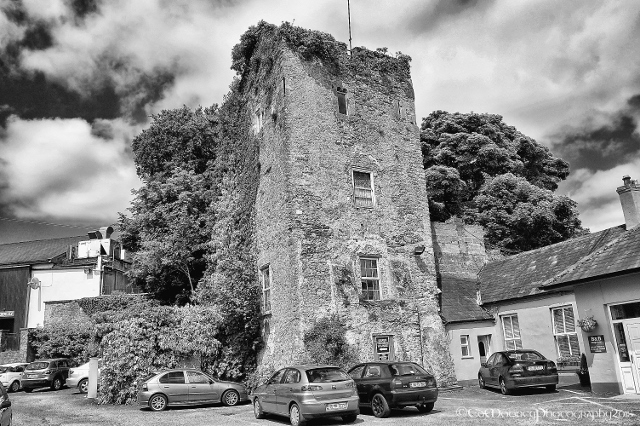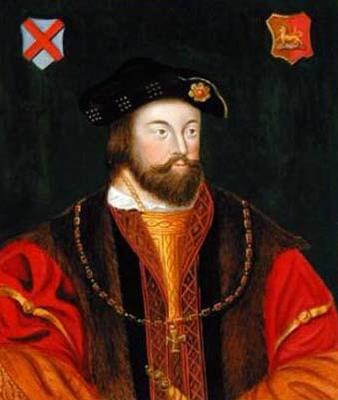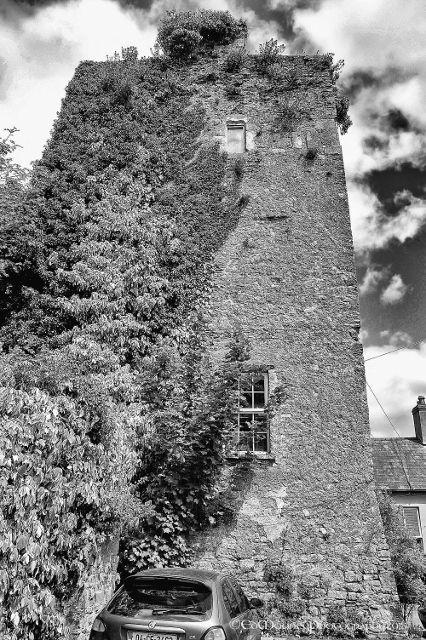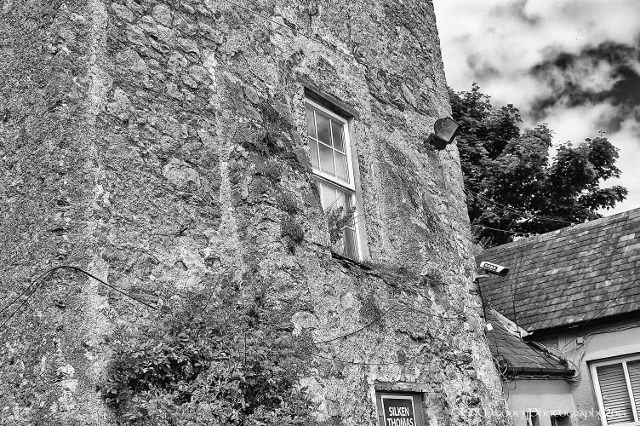It has been about four years since I first visited what remains of Kildare Castle. With the wealth of heritage sites in the area such as the Cathedral and the numerous Abbey’s you would expect to find a rather large fortification, considering Kildare’s precarious position on the edge of the Pale during Norman times and its connection to the infamous Geraldine dynasty. But unfortunately that is not the case. All that remains of this castle is a single solitary tower. If you were passing through the town you could be forgiven for missing it entirely. Strangely the tower is located in a little car park to the rear of the Silken Thomas pub, which bears the nick-name of Thomas Fitzgerald 10th Earl of Kildare.
Thomas was a rather interesting character, as were many of the Geraldine’s, whom although of Norman descent, where well known for becoming as some say ‘more Irish, than the Irish’. This would obviously not sit well with the Crown and despite their immense power; the Geraldine’s would go on to clash with the crown on numerous occasions. Young Thomas, whom was then ‘Lord Offaly’, was most famous for his open rebellion against the crown. When his father, Gerald the 9th Earl of Kildare was summoned to London, he made Thomas the Deputy Governor of Ireland in his absence at the age of 21. Three months later after hearing that his father had been executed in the Tower of London, Thomas summoned his council at St. Marys Abbey in Dublin and escorted by 140 heavily armoured Gallowglass, stormed the abbey and publicly renounced his allegiance to King Henry VIII, Lord of Ireland by throwing down his Sword of State. It was from these Gallowglass with silk fringes on their helmets that Thomas got his nick-name. Eventually he was captured in 1536 he was captured by the new Lord Deputy of Ireland, Leonard Grey. And was brought back to London, were he was executed in July 1537 at the ripe old age of 24. The sad part of this story is that his father had not been executed but had died in the Tower of ill health. The Geraldine line should have ended here, but Silken’s half-brother Garret Oge became the 11th Earl at the age of 12 and was whisked away to safety in France. He did not return to Ireland until much later when it was safe to do so, and so the Geraldine line continued. Garrett was another interesting character, also known as the Wizard Earl, which I have written about before.
The Castle at Kildare was without a doubt one of the most important Norman Castles in Leinster, and would have been ranked along with those of Carlow, Ferns and Kilkenny. But the first fortification in Kildare was not so grand. After the arrival of the Normans on Irish shores in 1169AD and the subsequent invasion which followed, it became common practise to take over existing monastic settlements for both strategic and commercial reasons. Kildare was one such location and it is reputed that Richard De Clare whom now held the lordship of Leinster after Diarmuid Mac Murrough’s death, made Kildare town his main base of operation and home. The original Castle would have been nothing more than a simple Moat & Bailey, and was located on a mound to the southeast of the current Castle. Although no visable traces of the earlier fortification remain, it is commonly believed that it was incorporated into the defences of the later structure. The first mention of a castle in Kildare occurs around 1185AD. It is not until 1302 were in an Inquisition mentions that the Castle had been built on the lands of the Church of Kildare without the consent of the Bishop.
The remains of what we now see today, come from the Castle which was built by De Clare’s Son in Law, William Marshall. It is believed to have been a polygonal enclosure with four towers, surrounded by a curtain wall and maybe a motte which covered almost half a hectare. Whilst there are still some portions of what was once the town walls in existence, this single tower is all that remains of the Castle at Kildare. It appears to be in pretty good condition with modernesque windows installed and a door which is marked as an emergency exit, so I wonder is it in use by the Silken Thomas pup, restaurant or accommodation centre?
Between 1297 & 1299 it is said that certain repairs were carried out to the houses, towers and gates, with a new bake house, kitchen and well, being constructed. The Castle was so well built that in 1316AD when Edward Bruce, Earl of Carrick and younger brother of Robert, King of Scotland, attacked Kildare, he was unable to break the defences, even after a three day siege.
By 1290Ad the Castle had passed on to the DeVescy family, where it prospered in relatively peaceful times. During this period, many religious houses were established in Kildare, with the construction of the new Cathedral on the site of Brigid’s Church of the Oak, the Franciscans and Carmelites both set up their respective Friaries and the Church of St. Mary Magdalene; complete with a hospital was in operation by 1307AD.
Then in 1316 after numerous altercations between William Vescy, Lord of Kildare, Lord Justice of Ireland and John Fitz Thomas (Fitzgerald), the King seized all Vescy lands in Kildare and granted them to John Fitzgerald along with the newly created title, Earl of Kildare. This was mainly in recognition of his services during the Bruce invasion of Ireland. And so began the long Geraldine association with Kildare. Kildare would go on to see much trouble especially during the Cogadh na Naoi mBliana (Nine Year War) 1594 to 1603 which led to the Flight of the Earls and the Cogadh na hAon Bhliana Déag (Eleven Year War/Confederate War) 1641-1653. But the Castle remained unscathed as the Geraldine’s had moved their seat of power to Maynooth.
Over the following centuries the castle slips into obscurity, with much of its fascinating history unknown. The last known Geraldine, Lord Edward Fitzgerald lived here in the 1790’s. If you have any additional information or stories relating to the castle in Kildare town or indeed and of the sites I visit, please get in touch, I would love to hear from you.
For these and more of my images, why not visit my Website or join me on Facebook or Twitter.












In the first picture the castle looks almost triangular/wedge-shaped! Great info and pics. Once again you are The Master!! 🙂
76.3 stars out of 10…
LikeLiked by 1 person
LOL, its just the angle, not a great shot in the technical sense, but who cares!
Glad you liked it Dan 🙂
LikeLike
Looks like it is under siege from a pack of cars here…
LikeLiked by 1 person
YEah, the cheek of them, no consideration for us photographers 🙂 its actually a little car park and is never empty. I have tried numerous times but can never get a clean shot of the place 🙂
LikeLiked by 1 person
Some places are just like that…
LikeLiked by 1 person
A nice history again Ed, and the castle tower lends itself well to the B+W photos too.
Best wishes, Pete.
LikeLike
Cheers Pete 🙂
LikeLike
What would castles be without the Normans?
LikeLiked by 1 person
Still standing, if Cromwell had gone on his holidays to spain instead of Ireland lol 🙂
LikeLike
Fascinating stuff, Ed. I’m interested in learning more about this period of history, particularly down Kerry way.
LikeLiked by 1 person
Yes Ali, my medieval knowledge is a bit limited in that part of the country. Most of what I know would be pre medieval. But Im hoping to spend a few days down in either Cork or Kerry with the clan, so fingers crossed I come back with a few shots and a little knowledge 🙂
LikeLiked by 1 person
Great… You may be able to answer some of my questions then.
LikeLiked by 1 person
Tell ya what, fire away now, you never know what might be lurking I. That head of mine.😊
LikeLiked by 1 person
I’m interested in Ross Castle, and the man who built it, O’Donaghue Mor, C16th I think.
LikeLiked by 1 person
Ok thats the one in Kilarney that you recently went to visit?
LikeLiked by 1 person
No I never went there. There is a different Ross Castle in Co Meath, which is where I went, complete coincidence and nothing to do with O’DM
LikeLike
Ok so three Ross Castles, Meath, Kerry and Wexford I think 🙂
These lads have a very messed up history, loads of different septs and the translation is messy Mor would normally been Big or older but in this case it seems to be Ó Donnchadha na nGleann. Feel free to correct me if im going of track.
LikeLiked by 1 person
I think that’s right. They split into 2 septs, he founded Ross Castle and his dynast there, the other branch moved somewhere else near Killarney, can’t quite remember without checking my notes, which I don’t have with me here!
LikeLiked by 1 person
http://www.libraryireland.com/Pedigrees1/ODonoghue3Heber.php
LikeLike
The other lot settled at Killaha Castle?
LikeLiked by 1 person
I think that’s right. They split into 2 septs, he founded Ross Castle and his dynast there, the other branch moved somewhere else near Killarney, can’t quite remember without checking my notes, which I don’t have with me here!
LikeLiked by 1 person
That’s them!!!
LikeLiked by 1 person
Do you have his first name? there are quite a few spoken about.
Im still not sure if we are going to Cork or Kerry yet, but Hazel is talking about stopping off in Limerick to visit her Aunt, so this trip might be a perfect opportunity as she lives nearby CastleConnell, my maternal ancestral home. Got to start making my bucket list now. Any sites you want me to try and visit?
LikeLiked by 1 person
I’d love to see pics of Ross Castle! Want to try and get there myself if I can, but as you know, not east to get away and do your own thing.
LikeLiked by 1 person
LOL, story of my life, Ill try my best to fit it in, it looks like we will be spending three days in Youghal and then heading up to Limerick. If so I should be able to swing across for a look around, fingers crossed 🙂
LikeLiked by 1 person
Cool! Let me know if you pick up any vibes. It was said he worshipped the devil and was in with the Sidhe, that be got sucked out the window of the top floor and lives under the lake. I have a feeling he was murdered.
LikeLiked by 1 person
Sounds like the church were trying to get their greedy hands on his lands ? Did you find out his first name?
LikeLiked by 1 person
No, but I’ll get back to you on that…
LikeLike
Isn’t it amazing how much power young people had back then? Incredible! Thanks for the bit of history. 🙂
LikeLiked by 1 person
My pleasure Laura, glad you liked it 🙂
LikeLiked by 1 person
So fascinating. I love reading the stories around these structures!
LikeLiked by 1 person
Thank you Karen, so glad that you enjoyed it 🙂
LikeLike
It seems so improper to use the tower this way, using it as a historic site seems better. Nice photos as always.
LikeLike
I love your history of these old stones of Ireland. and of course the images!! We’ll be in County Kerry in August!
LikeLiked by 1 person
Cool, im hoping to get down to Cork or kerry for a few days with the clan next month. I got truck loads of places i want to explore:-)
LikeLiked by 1 person
Nice piece Ed, great photos and we all love a bit of history. Being a Scotsman myself I had always understood it to be Ulster Castle that Bruce had attacked?
LikeLiked by 1 person
Amongst others, he was actually declared high king of Ireland and the oneills basically handed him Ulster, better to be with a fellow Gael, than a foreign king. But it meant nothing in reality. The Norman nobles in the other provinces would not kneel and he was eventually routed by the Lord of Louth. Hung drawn and quartered, with the head sent back to London and the rest sent to the four corners of Ireland.
But what annoys me is he borrowed our Lia fail, and never gave it back, the fecker.😱
LikeLike
I know I shouldn’t laugh, but ha ha ha ha. Excellent…!
LikeLiked by 1 person
Not funny mate, how the hell am I supposed to become King without it? I think Lizzie still plonks her arse on it from time to time? 🙂
LikeLiked by 1 person
Well you want to arrange a rescue like we did for the stone of scone. Just try not to lose it on the way….😢
LikeLiked by 1 person
Sounds like a plan 🙂
LikeLiked by 1 person
Love the fire exit in the castle. Anyway in case you are interested, the de Clare family that you mention were responsible for founding Clare College in Cambridge. Also, there is a town in Suffolk where their English estates were based (caput as it is known, meaning administrative centre) called Clare. Didn’t know they had been in Ireland.
LikeLiked by 1 person
Wow , thats very interesting. They were earls of Pembroke, right? I believe that he came over here with MacMurrough, as he was down on his luck at the time? He sure did well for himself.
Thanks for the info Jamie, I love finding out new little pieces of history 🙂
LikeLiked by 1 person
Yes, they were Earls of Pembroke they also held quite a number of other titles too, from what I can see. They are descended from the House of Normandy.
LikeLike
Great stuff, Ed. I still maintain that you have a book in you. A small irony that Edward Bruce had no luck in St. Bridget’s town of Kildare and then went on to die at Faughart, her birthplace, where he had been crowned King of Ireland two years previously. Maybe she put a hex on him. Keep up the good work.
LikeLiked by 1 person
Hi Hugh, hope your keeping well. That never even crossed my mind, and I only did a piece on her last week, lol. Well spotted. serves him right for not returning our Lia Fail 🙂
I need a hell of alot more experience before I attempt a book, but thanks, its definitly on the cards 🙂
LikeLike
Very interesting read, Ed. I enjoy traveling through the eyes of others, to places I am unable to visit. Your writing enables me to “see” so much. Thank you for sharing !
LikeLike
Excellent and most intriguing historical article. I love Ed Mooney’s photographs!
LikeLike
Reblogged this on authorericamilesblog and commented:
Fascinating historical article about Kildare Castle in Ireland and illustrated by Ed Mooney’s wonderful photographs.
LikeLiked by 1 person
Another great post, Ed.
William Marshall is a figure who fascinates me totally.
LikeLiked by 1 person
He sure was good at what he did, despite marrying into power, he and Isabel both did quite well for themselves 🙂
LikeLiked by 1 person
Mr. Mooney, I have an author friend, Steven Jay Griffel, who just published a novel called “Grossman’s Castle.” It’s a fascinating tale about David Grossman, an improbable Jewish hero from The Bronx, NY, who apparently inherits a castle in Germany and is invited by three mysterious German ambassadors to move over there and try out living there. David also inherits some kind of title and is apparently destined to be king of some small town there. The book is a contemporary novel, very well-written, with hints of comedy, as well as haunting drama, historical details, and a great deal of mystery. Mr. Griffel had been searching for a site to take a photo of a castle and serendipitously chanced upon an actual castle somewhere in The Bronx, NY, where he grew up as a boy. He uses a photo of that castle’s door as the cover for his novel. It’s an intriguing photo, which entices prospective readers to enter the door and explore the novel. Steven Jay Griffel is on Facebook, so you can access him there, if you’d like to get in touch. You can also find his novel on Amazon.com, if you’d like to read a preview. I thought somehow, because you were both so deeply interested in castles and Medieval history, you might like to feature an article about Steven and his new book (with perhaps more photos) on your blog, edmooneyphotography.
LikeLike
We have a phrase in England for ‘a step too far’ which is ‘going beyond the Pale’ I had no idea that ‘the Pale’ was a real geographical thing. Really interesting stuff.
Cheers
MTM
LikeLiked by 1 person
Never heard that before, but it makes sense. the Pale was the Norman controlled area of Leinster. They even built great big walls to keep the natives out and the crown gave substantial grants to anyone whom built Castles or Towerhouses along its border 🙂
LikeLiked by 1 person
Wow, that’s really intriguing. William’s wall in Ireland, kind of thing, all those years after Hadrian’s in the North of England!
Cheers
MTM
LikeLiked by 1 person
I’m so weirded out that you can pull a car right up to this ancient structure. What if you’re having a bad day, and you’re really tired, and you– d’oh– pull forward a little too far and knock it over? This seems especially possible with a pub adjacent…
LikeLiked by 1 person
After all these years, I would suspect that the car would come out the worse of the two 🙂
LikeLike
Ha!!
LikeLike